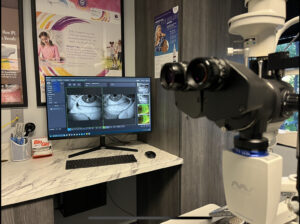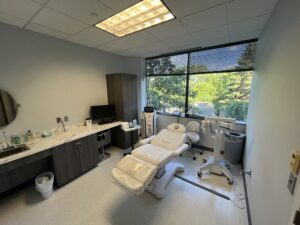
The slit lamp camera in Dr. Holland’s office. He says this technology has helped aid patient education and the process of reviewing dry-eye treatment options.
By Zachary Holland, OD, FSLS
August 2, 2023
The big investments you make in your practice can be hugely beneficial for patients and the practice alike–if they are the right investments. Here are a few ways I invested substantially into my staff, infrastructure and equipment, including how the investments enhanced care and my clinic’s profitability.
I estimate that these investments are delivering more than $750,000 in revenues annually.
Scribe
I disliked charting with the patient in the room, so I decided hiring a scribe would offer great benefits.
Cost: I hired a scribe for 20 percent more than what I would pay a pure technician.
Now, 100 percent of my time in the exam room is spent either examining the patient or discussing imaging results with the patient. I no longer need to pay attention to my computer monitor and charting nuances in the exam room. Better eye contact has allowed for better connections with my patients and has given the patient the time to open up about personal/family matters that may impact their care and visual needs. The investment in a scribe not only improved my ability to focus solely on patient care, but I can easily see 3-4 more patients daily.
I also was able to delay hiring an associate for about a year. I am just now getting to the point of absolutely needing to hire an associate, and pairing a scribe with a new OD to maximize their efficiency will be key. Having a scribe will also allow me the time to train my new associate while maintaining excellent care with a high cash flow.
In addition to scribing, this employee serves as a study coordinator. In this roll she takes over 80 percent of the time needed to set up/operate and document each study visit.
ROI: Obviously, calculating ROI of a clinical staff member is difficult because they aren’t directly generating any revenue. But by increasing my patient capacity by over 600 comprehensive exams per year, combined with making it easier for me to participate in clinical trials, this employee enabled me to generate upwards of $750,000 more revenue on in 2022.
If you want a scribe/tech, train them as a scribe first, and not the other way around. Doing it in this order will allow your staff to see the way you operate and how you do every test for months before they begin to tech for you. Staff in the exam room will hear how you explain every ocular condition and how you listen and document each chief complaint. Essentially, make this person your shadow. Their history-taking skills, clinical skills and documentation skills will only be as good as you are, so don’t get lazy when you have extra help.

Dry-eye treatment room with intense pulsed light (IPL) technology. Dr. Holland says he has been able to use the space to expand access to care for patients while growing profitability.
IPL/Procedure Room and Clinical Trials Room
I repurposed a 10 ft. by 14 ft. storage room in my clinic to operate as a procedure/intense pulsed light (IPL) room in 2022. And in 2023, converted most of the overly large front waiting room into a 18 ft. by 9 ft. long lane with specifications for clinical trials.
I wanted to push the scope of practice in my office, and because I have a high population of keratoconus patients, corneal cross-linking was the next obvious expansion of services at my clinic. The problem was we didn’t have a dedicated space to perform this procedure. So, I rented a storage space for $100 per month and built out a minor surgical procedure room that was perfect for corneal cross-linking services.
After six months, we had generated more revenue that I expected. So, to reinvest in the practice and lower my tax bill, I purchased an IPL and radio frequency (RF) instrument that could be used in the exact same space which is now designated as a minor surgical and dry-eye treatment suite.
In 2023, after even more revenue growth, we needed space for an incoming clinical trial. Many clinical trials don’t permit mirrors when checking acuity. All of my other lanes were about 10 feet. That meant I was opening the door to put the EDTRS chart in the hallway. This was unprofessional and messy. That’s when I contracted out the building of a clinical trial room.
Other Articles to Explore
Cost: The cross-linking and IPL instruments and the build-out of the room cost around $120,000. The clinical trial room cost us around $33,000 for build-out and another $10,000 for mostly used lane equipment.
This exam lane can now be used for routine care, but it is primarily used for the nuances of clinical trials. My office is now more attractive to clinical trial sponsors as I have a dedicated study coordinator and specific office space for these activities, thus increasing the odds of attracting more and better-paying clinical trials.
I purchased the cross-linking instrumentation with a five-year, 0 percent loan through the manufacturer in 2022. My payments for this instrumentation come to about $2,200 monthly and are paid for by less than 1 treatment per eye. The IPL and procedure room upgrades were paid for in cash. The clinical trial room and equipment were also paid for in cash.
ROI: The cross-linking and IPL instrumentation breakeven point was just 2-3 months. The clinical trial room will generate over $100,000 from a single study in the first 12 months.
By the time the $33,000 bill was needing to be paid, three months after starting construction, I had already been paid $36,000 in revenues from existing clinical trials.
Corneal cross-linking generated around $590,000 in gross collected in 2022 and IPL generated $40,000 in revenues the first six months. The clinical trials we participate in almost always generate more than $100,000 annually.
These investments have allowed us to offer more diverse dry eye and specialty services to our patients, and I hope to grow into aesthetics services down the road. We no longer have to refer out corneal cross-linking. This allows for better continuity of care and amazing clinical revenue if you can put the hard work in on the front end, like I did.
Slit Lamp Camera for Meibography & Optomap
I wanted to increase dry-eye evaluation options and patient education while increasing exam efficiency and documentation. Neither of these purchases were intended to directly expand clinical revenue significantly, but more the patient experience.
Cost: We paid $16,000 cash for the slit camera with meibography and videography capability and $77,000 cash for an optomap.
ROI: The slit-lamp camera generates about $20 per image with insurance reimbursement and our optomap generates $39 per image. It will take 2-3 years to break even, but my intent for purchasing the slit-lamp camera was to increase IPL revenue by enhancing patient education about dry eye. When I can show the patient the images of their eyes that led to my diagnosis of dry eye, I have found patients are more likely to accept higher levels of treatment because they can see the issues with their own eyes.
I can’t say for sure, but I project that I will be able to increase the number of people electing for IPL treatment by over 50 percent as a result of this improved patient education.
If you have more than one exam room, be prepared to budget and purchase multiple slit-lamp cameras the following year. I am already budgeting for this in 2024! In part, by implementing these changes, my revenue per patient has increased from around $900 in 2020 to approximately $1,900 over the last 12 months.
 Zachary Holland, OD, FSLS, is the owner of Cornea & Contact Lens Institute of Minnesota. To contact him: drholland@corneaandcontactlensinstitute.com
Zachary Holland, OD, FSLS, is the owner of Cornea & Contact Lens Institute of Minnesota. To contact him: drholland@corneaandcontactlensinstitute.com

























